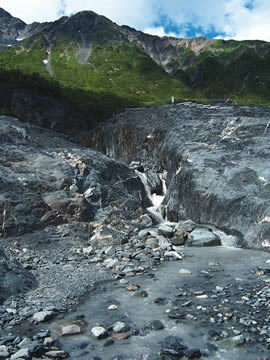
Light-colored granodiorite is common along much of the park’s coast and formed when a piece of the Pacific plate subducted underneath the North American plate. During the subduction, some rock melted into magma, which intruded and cooled to form plutons inside the local bedrock. In many areas, the softer sedimentary rocks that once surrounded the granodiorite plutons have eroded, leaving the harder rock standing as sea stacks and capes. NPS Photo by Paul Ollig The stark beauty of a land shrouded in ice, bordering the ocean, and teeming with wildlife covers a plot taking place underneath it all. Beneath the splendor, larger forces are at work. The movement of tectonic plates and the delivery and formation of various rock types prescribe where birds nest, where Steller sea lions breed, and where glaciers flow. The varying rock of the fjords underwrites the spectacle seen above— in one place eroding into graceful arches, in another withstanding the ocean’s constant blows. Crustal Collision Continental plates are pieces of crust visible as the continents of the Earth. Oceanic plates are heavier pieces of crust, sinking lower into the mantle and are covered by oceans. The plates collide at their edges, causing earthquakes. The collision of plates also builds mountains. Mysteries of Movement In the park, as the North Pacific oceanic plate subducts beneath us, it is now dragging the edge of the continent down with it. The Kenai Mountains are very gradually sinking below the sea. Evidence for this is found in the lovely half-moon coves of Aialik Bay. In the heyday of the Ice Age, which began about 1.8 million years ago, ice built up in the curve of every peak, gouging out cirques; high valleys that nourished glaciers. A warming climate raised sea level 10,000 years ago and snow falling at lower elevations melted in the summers, no longer transforming to glacial ice. The cirques are now drowned in ocean water and the peaks that edged above Pleistocene ice are now islands surrounded by sea. |
Last updated: April 14, 2015
